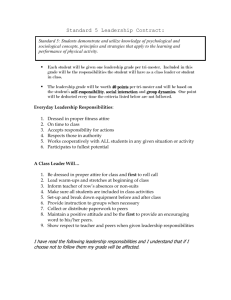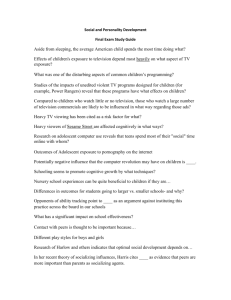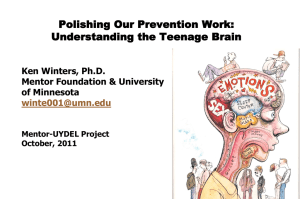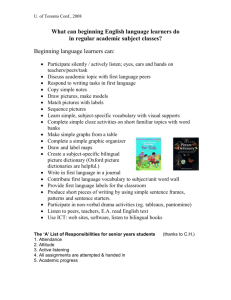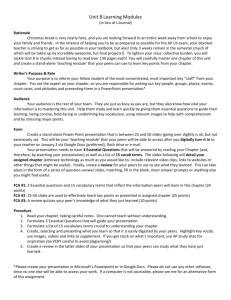Systematic Adaptive Behavior Characteristics Checklist
advertisement
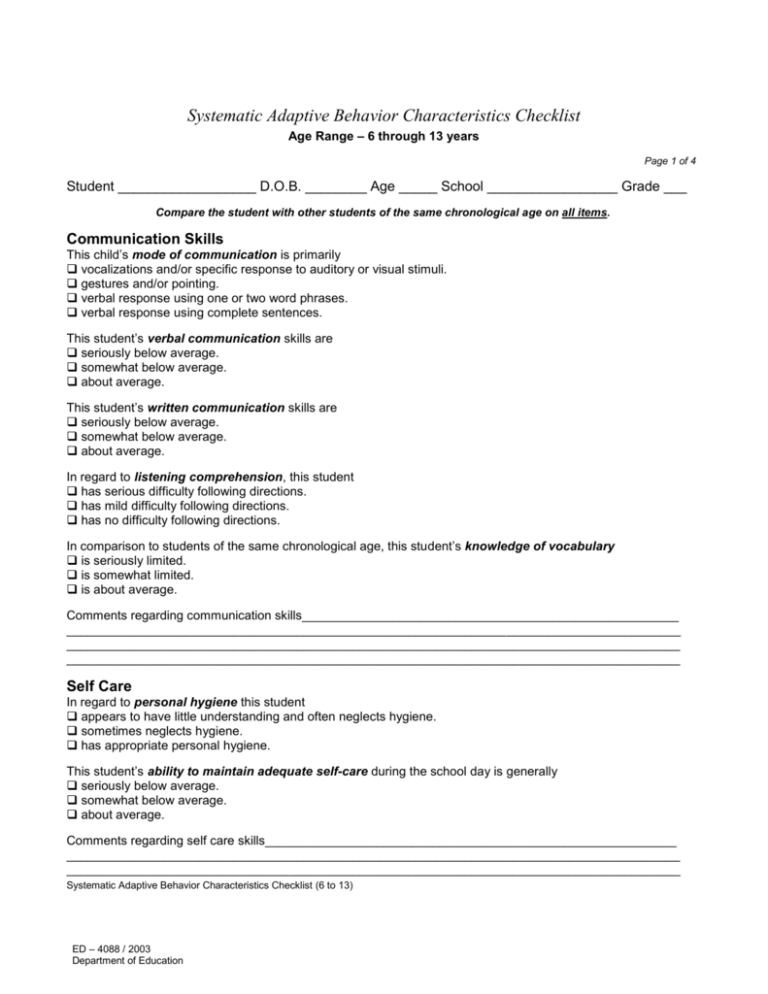
Systematic Adaptive Behavior Characteristics Checklist Age Range – 6 through 13 years Page 1 of 4 Student __________________ D.O.B. ________ Age _____ School _________________ Grade ___ Compare the student with other students of the same chronological age on all items. Communication Skills This child’s mode of communication is primarily vocalizations and/or specific response to auditory or visual stimuli. gestures and/or pointing. verbal response using one or two word phrases. verbal response using complete sentences. This student’s verbal communication skills are seriously below average. somewhat below average. about average. This student’s written communication skills are seriously below average. somewhat below average. about average. In regard to listening comprehension, this student has serious difficulty following directions. has mild difficulty following directions. has no difficulty following directions. In comparison to students of the same chronological age, this student’s knowledge of vocabulary is seriously limited. is somewhat limited. is about average. Comments regarding communication skills______________________________________________________ ________________________________________________________________________________________ ________________________________________________________________________________________ ________________________________________________________________________________________ Self Care In regard to personal hygiene this student appears to have little understanding and often neglects hygiene. sometimes neglects hygiene. has appropriate personal hygiene. This student’s ability to maintain adequate self-care during the school day is generally seriously below average. somewhat below average. about average. Comments regarding self care skills___________________________________________________________ ________________________________________________________________________________________ ________________________________________________________________________________________ Systematic Adaptive Behavior Characteristics Checklist (6 to 13) ED – 4088 / 2003 Department of Education Page 2 of 4 Student ____________________________________________ Compare the student with other students of the same chronological age on all items. Social Skills This student’s interaction with peers appears to be seriously immature. somewhat immature. about average. This student’s interaction with adults appears to be seriously immature. somewhat immature. about average. In regard to understanding social interaction (verbal and nonverbal cues, saying please and thank you, apologizing when appropriate), this student generally seems seriously limited. seems somewhat limited. appears to understand adequately. Comments regarding social skills______________________________________________________________ ________________________________________________________________________________________ ________________________________________________________________________________________ ________________________________________________________________________________________ School/Home Living In the school or home setting, this student is unable or requires supervision to complete daily tasks or chores. is limited in the completion of daily tasks or chores. is able to complete daily tasks or chores with little or no assistance. Comments regarding school/home living________________________________________________________ ________________________________________________________________________________________ ________________________________________________________________________________________ ________________________________________________________________________________________ Community Use When moving about the school and/or community, this student needs full supervision to move about the school/community. is able to move about the school/community with some assistance. is able to move from place to place with little or no assistance. In regard to school and/or community rules, this student always exhibits inappropriate behaviors and rule violations, which appears to be due to a lack of understanding. sometimes exhibits inappropriate behaviors and rule violations, which appear to be due to a lack of understanding. typically exhibits appropriate behaviors. Comments regarding community use___________________________________________________________ ________________________________________________________________________________________ ________________________________________________________________________________________ ________________________________________________________________________________________ Systematic Adaptive Behavior Characteristics Checklist (6 to 13) ED – 4088 / 2003 Department of Education Page 3 of 4 Student ____________________________________________ Compare the student with other students of the same chronological age on all items. Self-Direction In regard to working independently, this student requires much more assistance and supervision than peers. requires somewhat more assistance and supervision than peers. is about the same as peers. In regard to self correction of behavior, this student rarely exhibits self correction. is sometimes able to self correct. is about the same as peers in regard to self correction. When compared to peers in the ability to plan and organize tasks and activities, this student has serious difficulty planning and organizing. needs some assistance with planning and organizing. is as capable as peers to plan and organize. Comments regarding self direction_____________________________________________________________ ________________________________________________________________________________________ ________________________________________________________________________________________ ________________________________________________________________________________________ Health and Safety In regard to safety issues, this student disregards danger signals and would put himself/herself in danger without supervision. has some understanding of dangerous situations. understands as well as peers the need to avoid dangerous situations. In regard to personal health and safety issues, this student has little or no understanding. has some understanding. is comparable to peers in regard to health and safety issues. In regard to illness or injury, this student seems unable to exhibit behaviors to help himself/herself. responds, but needs more assistance than others his/her age. exhibits appropriate behaviors to deal with the situation. Comments regarding health and safety_________________________________________________________ ________________________________________________________________________________________ ________________________________________________________________________________________ ________________________________________________________________________________________ Functional Academics (ability to use skills as part of daily living skills) In regard to functional reading skills, this student is significantly below peers (3 or more grade levels). is somewhat below peers (2 to 3 grade levels). is about average with peers (no more than 2 grade levels). In regard to functional math skills, this student is significantly below peers (3 or more grade levels). is somewhat below peers (2 to 3 grade levels). is about average with peers (no more than 2 grade levels). Systematic Adaptive Behavior Characteristics Checklist (6 to 13) ED – 4088 / 2003 Department of Education Page 4 of 4 Student ____________________________________________ Compare the student with other students of the same chronological age on all items. In regard to functional writing skills, this student is significantly below peers (3 or more grade levels). is somewhat below peers (2 to 3 grade levels). is about average with peers (no more than 2 grade levels). Comments regarding functional academics______________________________________________________ ________________________________________________________________________________________ ________________________________________________________________________________________ ________________________________________________________________________________________ Leisure In regard to free time or play time, this student seems to have little or no idea how to spend free time. has some idea how to deal with free time. uses free time appropriately. When playing games with peers, this student has serious difficulty following rules, taking turns, and interacting appropriately. has some difficulty following rules, taking turns, and interacting appropriately. is as able as peers to follow rules, take turns, and interact appropriately. Comments regarding leisure time activities______________________________________________________ ________________________________________________________________________________________ ________________________________________________________________________________________ ________________________________________________________________________________________ Please add any other comments or information that will assist in evaluating this student’s adaptive behaviors appropriately. ________________________________________________________________________________________ ________________________________________________________________________________________ ________________________________________________________________________________________ ________________________________________________________________________________________ ________________________________________________________________________________________ ________________________________________________________________________________________ ________________________________________________________________________________________ ________________________________________________________________________________________ ________________________________________________________________________________________ ________________________________________________________________________________________ ________________________________________________________________________________________ ________________________________________________________________________________________ ________________________________________________________________________________________ ________________________________________________________________________________________ ________________________________________________________________________________________ ________________________________________________________________________________________ _________________________________ Signature of Observer __________________________ Relationship to Child ___________ Dates of Observation(s) Systematic Adaptive Behavior Characteristics Checklist (6 to 13) ED – 4088 / 2003 Department of Education LOUDON COUNTY SCHOOLS SYSTEMATIC OBSERVATION – ADAPTIVE BEHAVIOR Age Range – 6 through 13 years (Additional Documentation of Adaptive Behavior Functioning in Home or School) Page 1 of 2 Student __________________ D.O.B. ________ Age _____ School _________________ Grade ___ Compare Target Student (whose name is above) with peer of same age (Control Student). Control Student should have approximately age appropriate skills. Mark Y (yes), N (no), or NK (not known) for each behavior on both students. Some items can be completed by interview of teacher or target student. Area: Communication Target Control Examples of “N” Marked items for Target Student 1. States first and last name when asked 2. Speaks in full sentences 3. Follows instructions requiring an action and an object 4. Listens to a story for 5 minutes 5. Vocabulary seems appropriate for age 6. Starts a conversation of interest to others 7. Length and content of verbal interactions are age appropriate Area: Self-Care Target Control Examples of “N” Marked items for Target Student 1. Buttons coat 2. Takes care of personal needs (i.e. toileting, washing hands) 3. Ties shoes 4. Can find restroom unassisted 5. Wears appropriate clothing for weather conditions 6. Can go through lunch line without assistance 7. Can go to office without assistance Area: Social Skills Target Control Examples of “N” Marked items for Target Student 1. Uses names of others 2. Participates in group activities at recess or during free time 3. Has more than one friend 4. Not overly dependent on others 5. Shows sympathy for others when they are sad or upset 6. Shows interest in the ideas others 7. Congratulates others when something good happens Area: School/Home Living Target Control Examples of “N” Marked items for Target Student 1. Shows respect for the property and rights of others 2. Cleans up materials around desk or table 3. Changes easily from one activity to another 4. Keeps up with personal belongings 5. Returns borrowed books and supplies Area: Community Use Target Control Examples of “N” Marked items for Target Student 1. Demonstrates understanding of the function of money 2. Obeys people in authority 3. Understands the function of a clock 4. Runs errands to various locations in school building 5. States current day of the week when asked 6. States value of penny, nickel, dime, & quarter Systematic Observation – Adaptive Behavior (6 to13) ED – 4088 / 2003 Department of Education LOUDON COUNTY SCHOOLS SYSTEMATIC OBSERVATION – ADAPTIVE BEHAVIOR Age Range – 6 through 13 years (Additional Documentation of Adaptive Behavior Functioning in Home or School) Page 2 of 2 Student ____________________________________________ Compare Target Student (whose name is above) with peer of same age (Control Student). Control Student should have approximately age appropriate skills. Mark Y (yes), N (no), or NK (not known) for each behavior on both students. Area: Self-Direction Target Control Examples of “N” Marked items for Target Student 1. Routinely stays put when asked 2. Follows classroom rules 3. Completes routine classroom tasks in a reasonable amount of time 4. Controls anger or hurt feelings when denied his/her own way 5. Apologizes for mistakes or errors in judgment 6. Keeps working on the assigned task even when difficult 7. Asks for help when needed Area: Health & Safety Target Control Examples of “N” Marked items for Target Student 1. Does not intrude into the personal space of others 2. Handles school equipment appropriately 3. Follows safety rules on playground 4. Shows caution around dangerous activities 5. Asks to see School Nurse or other adult when ill or hurt. Area: Functional Academics Target Control Examples of “N” Marked items for Target Student 1. Counts from 1 to 10 2. Recognizes all letters of alphabet. 3. Reads own name 4. Reads words appropriate for age 5. Writes first and last name without model 6. States days of the week in order 7. Locates important dates on calendar Area: Leisure Target Control Examples of “N” Marked items for Target Student 1. Plays with toys or other objects alone or with others 2. Shows interest in the activities of others 3. Shares toys or possessions without being told to do so 4. Follows rules in a simple game without being reminded 5. Tries a new activity to learn something new 6. Invites a peer to join a game _________________________________ __________________________ _______________ Signature of Observer Relationship to Child Dates of Observation(s) Systematic Observation – Adaptive Behavior (6 to13) ED – 4088 / 2003 Department of Education
